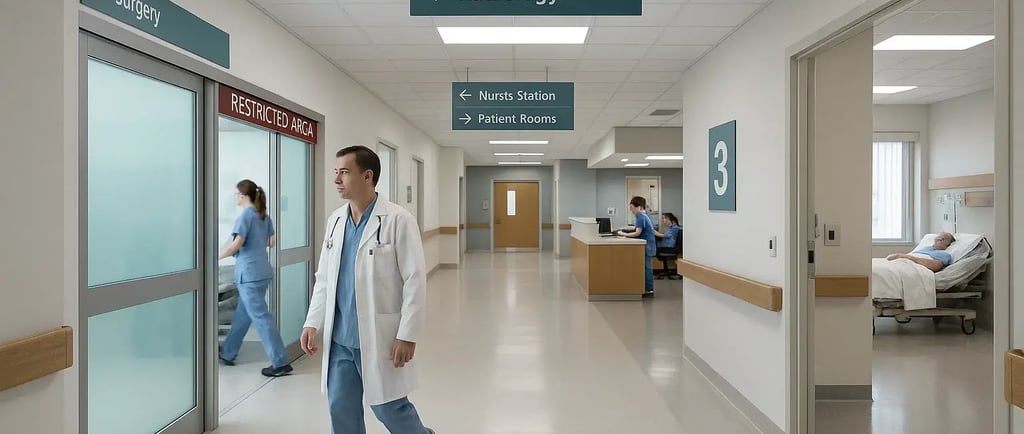Hospital Zoning & Circulation: Designing for Safety, Hygiene & Efficiency
Understand the principles of hospital zoning and circulation planning. Learn how effective spatial layout enhances infection control, staff efficiency, and patient experience in healthcare facilities.
7/4/20252 min read


Introduction: Why Zoning is the Heart of Hospital Planning
When designing a hospital, a beautiful façade is meaningless without a functionally optimized internal flow. Patients, staff, materials, and waste must move through clearly defined zones — each isolated by hygiene risk and functional need. At Archora, we specialize in spatial strategies that create safe, efficient, and regulatory-compliant hospitals.
This guide explores the core principles of hospital zoning and circulation and how they impact every layer of design — from layout to MEP systems.
1. What is Hospital Zoning?
Hospital zoning refers to dividing the facility into zones based on hygiene sensitivity, risk levels, and access control. This supports infection prevention, operational clarity, and licensing compliance.
Primary zones include:
Clean zone: OT, ICU, CSSD
Semi-clean zone: OPDs, diagnostic labs, nurse stations
Non-clean zone: Admin, reception, waiting areas
Dirty zone: Utility, biomedical waste, linen, janitor rooms
2. Circulation Planning: People, Materials & Waste
Hospitals serve multiple flows — patients, staff, equipment, medicine, food, linen, and waste. Each requires its own circulation logic.
A. Patient Flow:
Outpatients (OPD) must not intersect with critical care (ICU, OT)
Inpatients require direct access from wards to diagnostics/OT
B. Staff Flow:
Dedicated service corridors
Changing rooms, sterile zone entry points
C. Material Flow:
Vertical shaft planning for gas, electrical, linen chute
Separation of clean and soiled materials
D. Biomedical Waste Flow:
Reverse flow from OT, ICU, wards to disposal yard
Segregated corridor access for waste carts
3. Vertical & Horizontal Zoning in Multistorey Hospitals
Horizontal Zoning (per floor):
Public front: OPDs, diagnostics, waiting
Mid-core: Nursing/admin/staff areas
Rear: Critical and restricted zones
Vertical Zoning (across floors):
Lower floors: OPDs, labs (high access)
Mid floors: Wards and ICUs (moderate access)
Top floors: OT, sterile storage (restricted access)
Pro tip: At Archora, we always align staircases, lifts, and MEP shafts with zoning needs to prevent cross-contamination and support efficient circulation.
4. Access Control & Infection Barriers
Hospital zoning isn’t just spatial — it’s regulatory. Access must be limited across zones to reduce microbial load and meet NABH standards.
Design elements include:
Airlocks and anterooms between clean and semi-clean zones
Keycard or staff-only access to sterile areas
Doors with signage and sensor control
HVAC zoning:
Individual AHUs per zone to prevent air mixing
Positive pressure in clean zones (OTs), negative in dirty zones
5. Case-Based Zoning Examples by Archora
A. 40-bed Multispeciality Hospital:
ICU placed adjacent to OT with sterile corridor linkage
CSSD directly below OT for clean instrument transfer
B. Eye Hospital Layout:
Diagnostic zones separated from surgical zones
Visual wayfinding aids for patients with impaired vision
All our zoning layouts are reviewed by clinical teams and optimized for licensing, comfort, and flow clarity.
Conclusion: A Well-Zoned Hospital is a Safe Hospital
Zoning is the invisible framework of every successful hospital. It influences infection control, time efficiency, patient comfort, and NABH/Fire approval compliance. At Archora, we integrate zoning at the earliest stage of planning, ensuring every project is built on safe, intelligent flow.
Need a zoning plan that meets compliance and clinical logic? Contact Archora for expert healthcare planning.
Recommended Reading:
Healing by Design: How Architecture Influences Patient Recovery
Hospital Licenses & Approvals in India: A Complete Design-to-Commissioning Guide

ARCHORA
Where Infrastructure Inspires Healing
Innovate
Inspire
© 2025. All rights reserved.
Create
